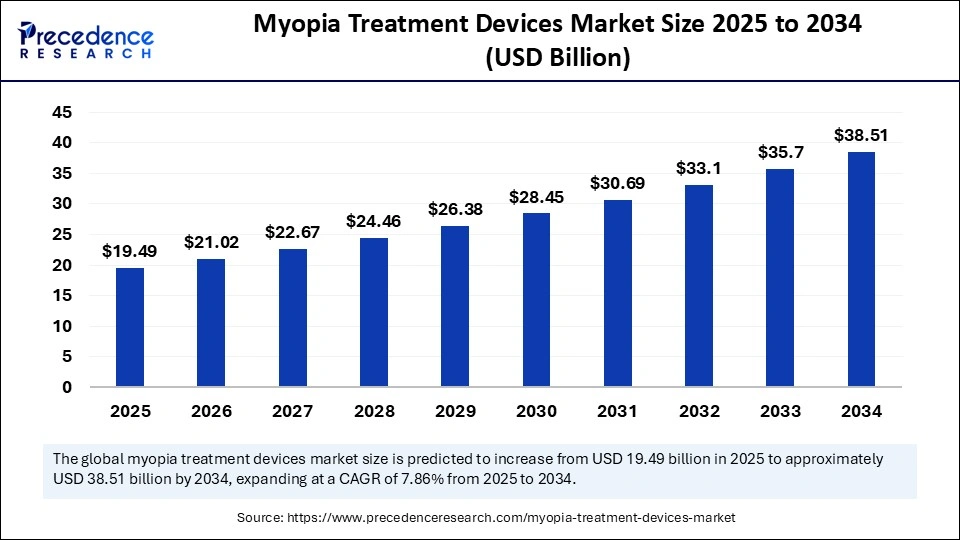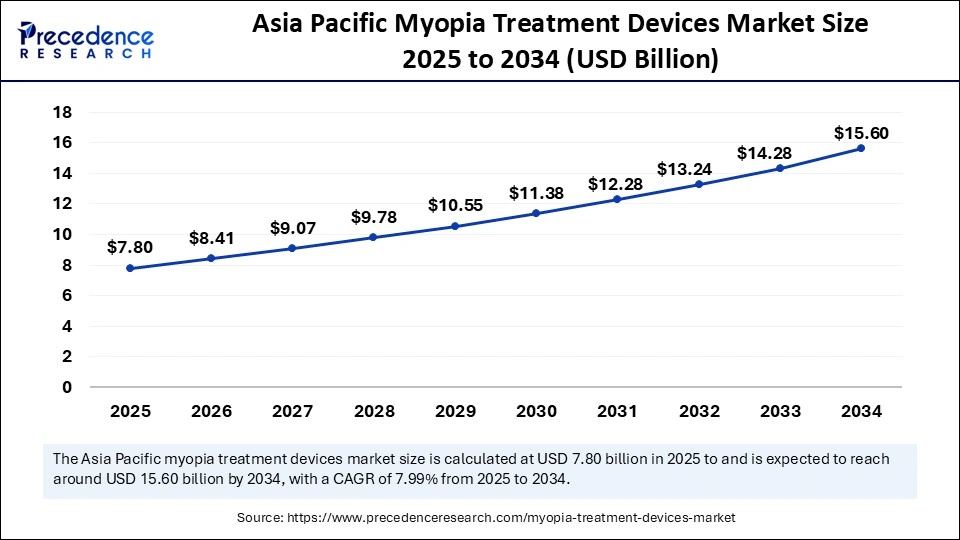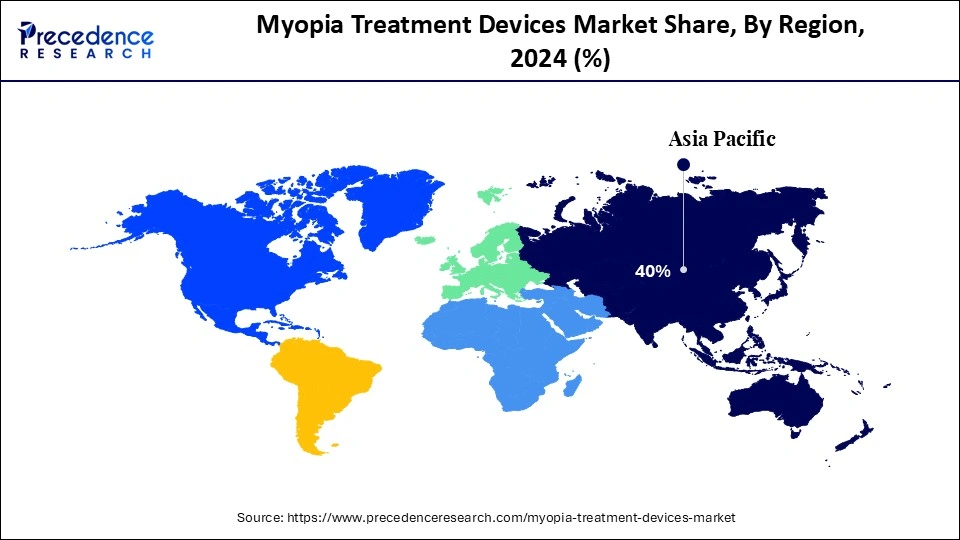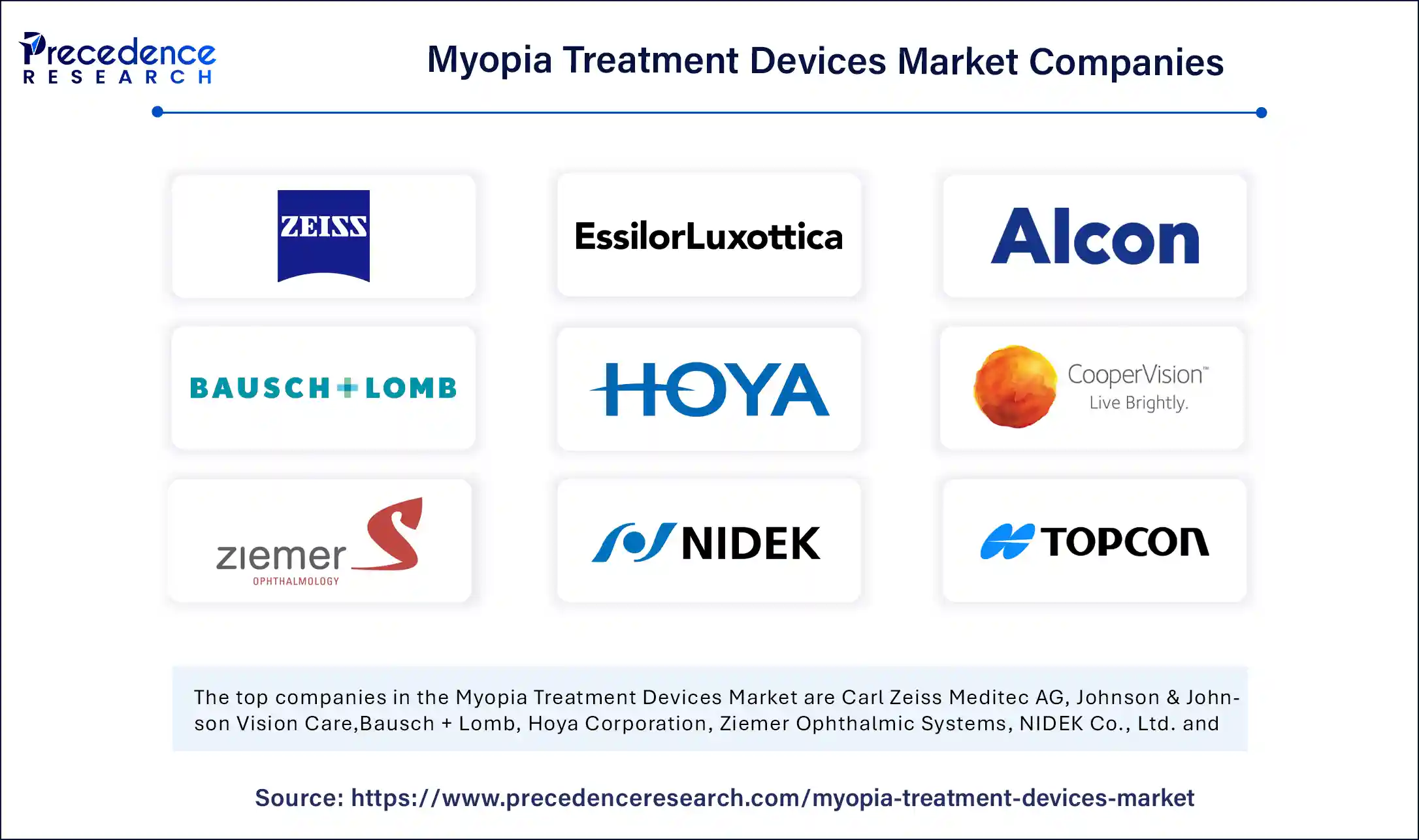List of Contents
Myopia Treatment Devices Market Size and Forecast 2025 to 2034
The global myopia treatment devices market size accounted for USD 18.07 billion in 2024 and is predicted to increase from USD 19.49 billion in 2025 to approximately USD 38.51 billion by 2034, expanding at a CAGR of 7.86% from 2025 to 2034. This market is growing due to the rising prevalence of vision disorders among younger populations and the increasing adoption of advanced corrective technologies.

Myopia Treatment Devices Market Key Takeaways
- In terms of revenue, the global myopia treatment devices market was valued at USD 18.07 billion in 2024.
- It is projected to reach USD 38.51 billion by 2034.
- The market is expected to grow at a CAGR of 7.86 % from 2025 to 2034.
- Asia Pacific dominated the myopia treatment devices market with the largest market share of 40% in 2024.
- North America is expected to grow at the fastest CAGR during the forecast period.
- By product type, the eyeglasses segment held the biggest market share of 40% in 2024.
- By product type, the orthokeratology lenses segment is expected to grow at the fastest CAGR during the forecast period.
- By end user, the ophthalmic clinics segment held the largest share of 38% in 2024.
- By end user, the ambulatory surgical centers segment is projected to grow at the fastest CAGR during the forecast period.
- By patient age group, the adult segment generated the major market share of 55% in 2024.
- By patient age group, the children & adolescents' segment is the fastest-growing segment during the forecast period.
- By distribution channel, the optical retail chains segment accounted for the significant market share of 42% in 2024.
- By distribution channel, the online platforms segment is emerging as the fastest-growing during the forecast period.
How Is AI Transforming the Myopia Treatment Devices Market?
Artificial intelligence is revolutionizing the market for myopia treatment devices by facilitating more accurate diagnosis, earlier detection, and individualized myopia treatment. Large datasets from patient eye exams are analyzed by machine learning algorithms to identify high-risk individuals and forecast the progression of myopia, enabling patient-specific interventions. AI-powered imaging technologies decrease human error by improving the precision of refractive evaluations, retinal scans, and corneal measurements. AI integration also facilitates the creation of intelligent corrective devices like smart contact lenses and orthokeratology lenses, which can continuously assess eye health and modify treatment as necessary. In addition to improving patient outcomes, this boosts clinic and practitioner efficiency.
Asia Pacific Myopia Treatment Devices Market Size and Growth 2025 to 2034
The Asia Pacific myopia treatment devices market size was exhibited at USD 7.80 billion in 2025 and is projected to be worth around USD 15.60 billion by 2034, growing at a CAGR of 7.99% from 2025 to 2034.

What Made Asia Pacific Dominate the Market for Myopia Treatment Devices in 2024?
Asia Pacific is dominating the myopia treatment devices market because of myopia's high prevalence, growing awareness, and sizable population. Market dominance is also supported by government initiatives, school-based eye care programs, and the expansion of ophthalmic clinics. The need for advanced treatment tools and corrective lenses is increasing as a result of lifestyle changes, increased urbanization, and the use of digital devices. Local lens manufacturing and technological partnerships also support the local market.

North America is the fastest-growing regional market for myopia treatment devices. The adoption of sophisticated corrective devices, rising healthcare costs, and growing awareness of the progression of myopia are all contributing to the rapid growth. Additionally, driving market expansion are advancements in non-invasive treatments, insurance coverage for corrective lenses, and tele-optometry services. Additionally, the growth prospects in this region are improved by rising investments in research and development for pediatric myopia control solutions.
Market Overview
The global myopia treatment devices market is witnessing robust growth, motivated by growing awareness of eye health and early intervention, as well as the growing prevalence of myopia in children, adolescents, and adults. Corrective lens eyeglasses and ophthalmic clinics are the market's main end users, but orthokeratology lenses, ambulatory surgical centers, and internet distribution channels are also expanding quickly. Adoption is being fueled by technological developments in lens design, non-invasive procedures, and tele-optometry services, as well as changes in lifestyle and a rise in the use of digital devices.
Myopia Treatment Devices Market Growth Factors
- Rising Myopia Cases: Increasing prevalence among children and young adults due to screen time and lifestyle changes is boosting demand.
- Technological Innovations: Advancements in Ortho-K lenses, smart lenses, and surgical devices are improving treatment outcomes.
- Early Diagnosis & Awareness: Growing awareness of long-term risks drives early intervention and adoption of devices.
- Higher Healthcare Spending: Rising investments in ophthalmology and better access in emerging economies support growth.
- Regulatory Support: Faster approvals for new devices are encouraging innovation and market expansion.
Market Scope
| Report Coverage | Details |
| Market Size by 2034 | USD 38.51 Billion |
| Market Size in 2025 | USD 19.49 Billion |
| Market Size in 2024 | USD 18.07 Billion |
| Market Growth Rate from 2025 to 2034 | CAGR of 7.86% |
| Dominating Region | Asia Pacific |
| Fastest Growing Region | North America |
| Base Year | 2024 |
| Forecast Period | 2025 to 2034 |
| Segments Covered | Product Type, End Use, Patient Age Group, Distribution Channel, and Region |
| Regions Covered | North America, Europe, Asia-Pacific, Latin America, and Middle East & Africa |
Market Dynamics
Drivers
Growing Myopia Burden
Myopia has become alarmingly more common around the world, especially in children and teenagers. Lifestyle shifts, urbanization, and a decline in outdoor activity are all strongly associated with this trend. The need for efficient treatment tools is growing as research indicates that by 2050, almost half of the world's population may be myopic. Governments, healthcare organizations, and manufacturers are being compelled by the increasing prevalence of disease to prioritize early intervention and long-term management strategies, leading to growth in the myopia treatment devices market.
- On 24 January 2025, HOYA Vision Care launched an extended power range version of its MIYOSMART spectacles lenses, designed for children with high myopia and astigmatism, offering slimmer edge thickness and compatibility with larger frames.(Source: https://www.hoyavision.com)
Advances in Device Technology
Rapid technological advancement has produced sophisticated solutions that help control or slow the progression of myopia, including smart contact lenses, atropine delivery devices, and orthokeratology lenses. Patients and physicians are becoming more receptive to these devices due to their increased comfort, safety, and accuracy. For severe cases, minimally invasive surgical techniques are also becoming more popular. In addition to satisfying present demand, this innovation wave is opening new avenues for the myopia treatment devices market expansion.
- On 23 June 2025, Copper Vision expanded its generation sight initiatives to provide no-cost myopia management to under-resourced children in Massachusetts and Rhode Island. (Source:https://coopervision.com)
Restraints
Regulatory Delays and Compliance Barriers
Before being approved, new devices for the treatment of pediatric myopia must go through a rigorous clinical validation process. Time to market is delayed by this process, which frequently takes years and necessitates large financial outlays. Smaller businesses find it difficult to afford compliance, which hinders their ability to innovate. Furthermore, regional differences in regulatory requirements make plans for international expansion more difficult. These obstacles prevent patients in need from receiving timely care.
- On 5 June 2025, Sydnexis Inc. received European Commission approval for SYD-101, but the long regulatory pathway illustrates delays many companies face before entering the market. (Source: https://www.businesswire.com)
Intense Market Competition
Numerous treatment options, including atropine drops, Ortho-K lenses, smart glasses, and refractive surgeries, are available through various suppliers in the myopia treatment devices market. It is challenging for one technology to dominate in this competitive environment. To stand out, businesses must spend a lot of money on marketing and innovations, which raises expenses. The competition among various solutions may cause customer adoption to fragment, which would slow the growth of individual device categories.
- On 24 February 2025, OCULUS Inc. introduced a new Myopia software package, signaling competition not only in lenses but also in diagnostic and monitoring technologies. (Source: https://reviewofmm.com)
Opportunities
Clinical Validation of Spectacles Leans Technologies
Current multi-center research keeps confirming the efficacy of myopia treatments based on spectacles, especially when it comes to uniformly slowing progression in a variety of populations. Clinical data from one and two years offer solid evidence of effectiveness and adaptability in the real world, boosting clinician confidence. This scientific confirmation paves the way for more comprehensive adoption and reimbursement practices for children.
- On 8 May 2025, ZEISS Vision Care confirmed that its MyoCare and MyoCare S spectacle lenses significantly slowed myopia progression over two years in Asian and European children, with 84% of European children adapting within three days.(Source: https://www.zeiss.com)
Cloud-Based Ortho-K Design Tools
By decreasing chair time and enhancing customization cloud cloud-powered lens fitting and diagnostic tools can expedite Orth-K adoption. With data-driven accuracy and remote collaboration, these solutions enabled practitioners to make them perfect for growing their services in underserved or emerging markets.
- On 17 March 2025, Bausch+Lomb launched “Arise,” a cloud-based Ortho-K lens kitting system in the U.S. designed to optimize lens design and increase clinical efficiency.(Source: https://www.market-scope.com)
Product Type Insights
Why Did the Eyeglasses Segment Dominate the Myopia Treatment Devices Market?
In the collective lenses segment, the eyeglasses subsegment is dominating the myopia treatment devices market, accounting for a 40% share. Eyeglasses remain the preferred choice among patients due to their affordability, ease of use, and wide availability across optical retailers. They are appropriate for a diverse spectrum of customers due to their adaptability in terms of styles and lenses for varying degrees of myopia. Furthermore, the growing popularity of fashion-forward eyewear has enhanced the global market for eyeglasses.
The orthokeratology lenses subsegment is the fastest-growing product type in the corrective lenses market. Demand is being driven by growing awareness of non-surgical vision correction techniques as well as growing adoption among kids and teenagers. Growth in lens design is being accelerated by technological developments like increased comfort, oxygen permeability, and customization. Furthermore, parents are increasingly looking for ortho-k lenses as a preventative measure to slow their children's progression of myopia.
End User Insights
Why Did the Ophthalmic Clinics Segment Dominate the Myopia Treatment Devices Market in 2024?
Ophthalmic clinics are dominating the myopia treatment devices market. The main option for patients looking for expert care is these clinics because they provide specialized services and cutting-edge diagnostic equipment. Their market dominance is a result of their well-established network of knowledgeable professionals and capacity to offer individualized treatment programs. Additionally, to improve patient accessibility and convenience, a growing number of clinics are incorporating teleoptometry and digital eye exams.
Ambulatory surgical centers represent the fastest-growing end-user segment. The growth of ASCs is being driven by the growing preference for outpatient procedures because of their cost-effectiveness, convenience, and quicker recovery times. Their adoption is also being aided by partnerships with insurance companies and the expansion of these centers into urban and semi-urban areas. ASCs are becoming a more appealing option for treating myopia due to advancements in minimally invasive corrective procedures and advanced technologies.
Patient Age Group Insights
Why Did the Adult Segment Dominate the Myopia Treatment Devices Market?
Adults dominate the myopia treatment devices market, since most patients who seek vision therapy or corrective lenses are in this age range. Adults' ongoing demand is influenced by several factors, including increased eye strain from work, extended screen time, and vision problems brought on by lifestyle choices. Adults are also more prepared to spend money on high-end lenses and cutting-edge equipment for long-term eye health. Adult adoption is also increasing as a result of awareness campaigns about the value of routine eye exams.
Children & adolescents are the fastest-growing age groups in the myopia treatment devices market. Key motivators include early intervention and growing parental awareness of managing the progression of myopia. Adoption is being accelerated by pediatric optometry programs, school screening programs, and the rising demand for myopia control lenses. Devices that lower the chance of developing high myopia later in life and are safe, noninvasive, and effective are becoming increasingly preferred by parents.
Distribution Channel Insights
What Made the Optical Retail Chains Segment Dominate the Myopia Treatment Devices Market in 2024?
Optical retail chains dominate the distribution of myopia treatment devices, offering a wide range of products, professional fitting services, and easy accessibility. They are the best option for customers due to their well-established presence, well-known brand, and alliances with significant lens producers. Personal consultations and in-stablished eye exams increase client satisfaction and trust. Retail chains also frequently implement loyalty plans and promotions to promote recurring business and maintain their market leadership.
Online platforms are the fastest-growing distribution channel in the market. The increase is being driven by convenience, competitive pricing, and the capacity to reach distant clients. Online platforms facilitate a smooth shopping experience by providing virtual try-on tools, home delivery, and product comparisons. The continuous digitization of healthcare services and growing confidence in online eyewear purchases are contributing to this channel's explosive growth.
Myopia Treatment Devices Market Companies

- Carl Zeiss Meditec AG
- Johnson & Johnson Vision Care
- EssilorLuxottica
- Alcon Inc.
- Bausch + Lomb
- Hoya Corporation
- CooperVision Inc.
- Ziemer Ophthalmic Systems
- NIDEK Co., Ltd.
- Topcon Corporation
- STAAR Surgical Company
- SCHWIND eye-tech-solutions
- Oculus Optikgeräte GmbH
- Menicon Co., Ltd.
- Contamac Holdings Limited
- Visioneering Technologies, Inc.
- Medennium Inc.
- Haag-Streit Group
- Luneau Technology Group
- Canon Medical Systems Corporation
Recent Developments
- On 10 June 2025, Dr. Agarwal's Eye Hospital began clinical trials of a new overnight corneal reshaping contact lens designed to slow eye elongation in children. The trial involves 200 participants and will last at least 18 months. (Source: https://timesofindia.indiatimes.com)
- On 11 June 2025, Pune Medical Center reported successful use of specialized lens implants for a patient with thin corneas, and unsuitable for LASIK, offering a viable alternative to improve vision in challenging refractive surgery scenarios.(Source: https://timesofindia.indiatimes.com)
Segments Covered in the Report
By Product Type
- Corrective Lenses
- Eyeglasses
- Contact Lenses
- Daily Wear Lenses
- Extended Wear Lenses
- Orthokeratology (Ortho-K) Lenses
- Others
- Surgical Devices
- Excimer Laser Systems (LASIK, PRK)
- Femtosecond Laser Systems (SMILE, Advanced LASIK)
- Implantable Collamer Lenses (ICLs)
- Phakic Intraocular Lenses
- Others
- Therapeutic & Progression Control Devices
- Atropine Delivery Devices
- Myopia Control Contact Lenses
- Specialized Spectacle Lenses for Myopia Control
- Others
- Diagnostic Devices
- Autorefractors
- Corneal Topographers
- Optical Coherence Tomography (OCT) Devices
- Wavefront Analysers
- Others
- Others
By End Use
- Hospitals
- Ophthalmic Clinics
- Ambulatory Surgical Centers
- Specialty Eye Care Centers
- Optical Stores & Retail Chains
- Others
By Patient Age Group
- Children & Adolescents
- Adults
- Geriatric Population
By Distribution Channel
- Direct Sales (Hospitals & Clinics)
- Optical Retail Chains
- Online Platforms
- Others
By Region
- North America
- Europe
- Asia Pacific
- Latin America
- Middle East & Africa
For inquiries regarding discounts, bulk purchases, or customization requests, please contact us at sales@precedenceresearch.com
Frequently Asked Questions
Ask For Sample
No cookie-cutter, only authentic analysis – take the 1st step to become a Precedence Research client